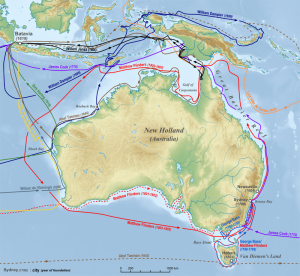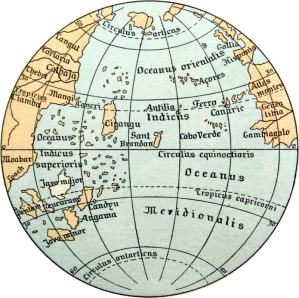
Yes, the answer to Tuesday’s final query is that the Dieppe maps, (including Guillaume Brouscon’s,) show a great big landmass almost exactly where Australia actually is, a good 50 or 60 years before the first documented European sighting. (By Dutch navigator Willem Janszoon, in 1606.)
 There’s this funny gap in human knowledge of Australia. 50,000 years ago, humans equipped with little more than sharp rocks and pointy sticks managed to get to Australia and make themselves home. Then, for the next 49,500 or so years, everyone else forgot that it was there. (Aside from a few lost souls from India who washed up, IIRC, abut 10,000 years ago.) (It looks like the southern coast of Australia wasn’t even explored [by sea,] until 1801.)
There’s this funny gap in human knowledge of Australia. 50,000 years ago, humans equipped with little more than sharp rocks and pointy sticks managed to get to Australia and make themselves home. Then, for the next 49,500 or so years, everyone else forgot that it was there. (Aside from a few lost souls from India who washed up, IIRC, abut 10,000 years ago.) (It looks like the southern coast of Australia wasn’t even explored [by sea,] until 1801.)
Even China, an organized polity with excellent record-keeping, ship-making, and map-making skills going back centuries, does not show Australia on its maps (at least not on any map I’ve found,) until 1602.
1602 is still before 1606, but we will discuss these Chinese maps in a minute.
Portugal had a policy, in the 1500s, of treating its nautical maps as official state secrets. French spies, therefore, went and bribed Portuguese map-makers into sharing their secrets, the results of which are probably the Dieppe maps, due to their many Portuguese and French labels, indicating French cartographers working off Portuguese originals.
All of which raises the question of WHO was exploring Australia in the early 1500s. Was it the Portuguese? If so, they’ve done an excellent job (a few bribed cartographers aside,) in keeping it secret. Unlike the fabled Viking settlement in Vinland, we have yet to discover any hard evidence, such as Portuguese DNA or artifacts in Australia, that would confirm an early Portuguese presence.
The “Australia” landmass on the Dieppe maps is labeled “Jave la Grande.” Wikipedia claims that this name comes from Marco Polo:
“As explained by Sir Henry Yule, the editor of an English edition of Marco Polo’s travels: “Some geographers of the 16th century, following the old editions which carried the travellers south-east of Java to the land of Boeach (or Locac), introduced in their maps a continent in that situation”.[3]”

The problem with this explanation is that in the two and a half centuries of map-making between the publication of Marco Polo’s adventures and the drawing of the Dieppe maps, no one stuck in a giant continental blob of land south of Indonesia, labeled “Jave la Grande” nor anything else. Jave la Grand does show up on some of these maps, but as a quite ordinary island about where you’d expect it. EG, the Erdapfel globe of 1492 (too early to include Columbus’s discoveries, which weren’t known until 1493, but definitely disproving the idea that people in Columbus’s day thought the world was flat.)
I find it highly unlikely that the Dieppe cartographers suddenly decided to turn “Jave la Grande” into a great big landmass in a spot where no prior European maps had ever shown land, and happened, totally by accident, to position it where there actually is a continent.

It seems far more likely that they were working off charts that happened to show a large landmass in this spot, and needing a name for it, they chose the closest thing they could find in Marco Polo’s account. (I would not worry about the location being slightly off, due to these maps predating our ability to find longitude at sea by over a hundred years.)
That leaves the question of how Australia got on the charts. Just as the French got their information from the Portuguese, the Portuguese may have gotten their information, in turn, from someone else, like the Chinese, Indonesians, or Islamic mariners.
The Wikipedia page on Islamic geography is inadequate for me to draw any conclusions from it.

As I mentioned earlier, the first Chinese maps (that I know of) to show Australia are from 1602, after the Dieppe maps. The Kunyu Wanguo Quantu were created by Matteo Ricci, an Italian Jesuit missionary. The Kunyu Wanguo Quantu combines, for the first time, the geographic knowledge of Europe and China.

Ricci got to China by hopping aboard a Portuguese vessel, which dropped him off at their colony in Goa. From there he traveled to Macau, and then to Beijing and the Forbidden City (though he never met the Emperor.) So I think it highly likely that Ricci had access to (or knowledge of) Portuguese maps/discoveries, or the Dieppe maps themselves. I suspect that Ricci’s knowledge of Australia did not come from Chinese sources, because the Chinese world map Shanhai Yudi Quantu, (1609,) though inspired by Ricci’s work, does not show Australia.
The Indonesians are another potential source. I don’t know anything about the history of Indonesian map-making, but the Wikipedia page on the prehistory of Australia intriguingly informs us:
…the people living along the northern coastline of Australia, in the Kimberley, Arnhem Land, Gulf of Carpentaria and Cape York had encounters with various visitors for many thousands of years. People and traded goods moved freely between Australia and New Guinea up to and even after the eventual flooding of the land bridge by rising sea levels …
Indonesian “Bajau” fishermen from the Spice Islands (e.g. Banda) have fished off the coast of Australia for hundreds of years. Macassan traders from Sulawesi regularly visited the coast of northern Australia to fish for trepang, an edible sea cucumber to trade with the Chinese since at least the early 18th century. Tamil sea-farers also had knowledge of Australia and Polynesia before European contact.[37] …
The myths of the people of Arnhem Land have preserved accounts of the trepang-catching, rice-growing Baijini people, who, according to the myths, were in Australia in the earliest times, before the Macassans. …
In 1944, a small number of copper coins with Arabic inscriptions were discovered on a beach in Jensen Bay on Marchinbar Island, part of the Wessel Islands of the Northern Territory. These coins were later identified as from the Kilwa Sultanate of east Africa. Only one such coin had ever previously been found outside east Africa (unearthed during an excavation in Oman).

So it is possible that the accounts of any of these folks could have made it onto local maps, and made their way from there to the Portuguese and the Dieppe maps (though I will note that if the Macassans got there in the 18th century, that is after the Dieppe maps, but I don’t know how exact that date is.)
There is, however, a potentially more mundane explanation for this odd landmass: it could just be South America. To European mapmakers of the late 14 and early 1500s, it was not at all clear that Columbus had discovered the edge of a new continent, rather than some islands off the coast of Asia–hence Ruysch’s 1507 map that show Massachusetts merging into China.

In the days before mariners could easily check their longitude at sea, the location of various islands could only be estimated by calculating the direction and speed the ship that had reached them had been going, eg, “Three days’ sail to the West.” This meant that islands could appear in different spots on different maps, which sometimes resulted in islands getting duplicated in maps created by compiling several earlier charts. Iceland, for example, shows up twice on this map:
I think it possible, therefore, that the Dieppe map makers had before them one map which showed the coast of Brazil as an island near Indonesia, and a second map showed it as part of a continent in between Europe and Asia, and simply recorded both on their combined map. Personally, I think the shape of Jave la Grande looks more like South America than Australia, but perhaps if I could read thee maps or examine them in more detail, I would revise that assessment.

This would be a case of the Dieppe map makers getting lucky, not unheard of phenomenon. Medieval Europeans believed, for example, in a mythical “fourth continent” located on the other side of the world, called fanciful names like “the antipodes” (“the backwards feet,” a reference to the amusing idea that people on the other side of the world are standing upside down relative to oneself–again, proof that Europeans well before Columbus knew the Earth is round;) or less fancifully, “terra australis,” “southern land.” Since the Bible commands Christ’s disciples to spread his Gospel to “the four corners of the Earth,” Medieval mapmakers, faced with only 3 continents, figured there had to be a fourth. But since philosophical opinions conflicted regarding this fourth continent, it was not always included on maps.
The European age of exploration pushed the borders of this fourth continent increasingly southward, as the vast expanse of the Pacific, Indian, and Atlantic oceans were found not to harbor it, until it was restricted to the area south of South America. But here folks got lucky, and spotted an actual continent right where their maps said there ought to be one. Likewise, when Australia first showed up on European maps, it was supposed to be a northern promontory of this most southerly land, and so depicted. Thus the name “Terra Australis” came to be inscribed on this territory.
So we are still left with a mystery: did someone actually map Australia before the Dutch, or did the Dieppe map makers just get lucky?
There is also this kangaroo story, which I have some doubts about it…
http://www.telegraph.co.uk/news/worldnews/australiaandthepacific/australia/10575227/Kangaroo-in-400-year-old-manuscript-could-change-Australian-history.html
LikeLike
It does look a lot like a kangaroo. Of course, it could just be a badly drawn rabbit, but intriguing nonetheless. Thanks!
LikeLiked by 1 person
Yes. It made some fuss a couple of years ago but, still, very doubful.
LikeLike
[…] Source: Evolutionist X […]
LikeLike
[…] Malays, Malaysia, pirates, Russia, Sumatra, The Pirates' Own Book, USS Potomac, war, warfare Matteo Ricci’s map of the Far […]
LikeLike